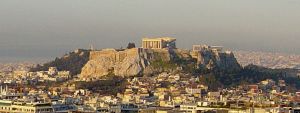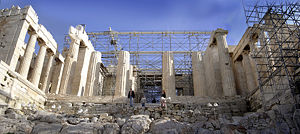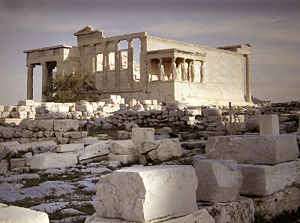Difference between revisions of "Acropolis" - New World Encyclopedia
| Line 15: | Line 15: | ||
}} | }} | ||
| − | The '''Acropolis of Athens''' is the best known [[acropolis]] (high city, The "Sacred Rock") in the world. Although there are many other acropoleis in Greece, the significance of the Acropolis of Athens is such that it is commonly known as | + | The '''Acropolis of Athens''' is the best known [[acropolis]] (high city, The "Sacred Rock") in the world. Although there are many other acropoleis in Greece, the significance of the Acropolis of Athens is such that it is commonly known as "The Acropolis" without qualification. The Acropolis is a flat-topped rock which rises 512 feet above sea level in the city of [[Athens]]. It was also known as [[Cecropia]], after the legendary [[snake|serpent]]-man, Kekrops or [[Cecrops I|Cecrops]], the first Athenian king. |
| − | The Acropolis of Athens was inhabited as far back as 3000 | + | The Acropolis of Athens was inhabited as far back as 3000 B.C.E., and by the year 1400 B.C.E. had become part of a powerful [[Mycenaean]] city. Legend recounts that in the year 510 B.C.E. an [[oracle]] from the [[priestess]] of [[Delphi]] decreed that the Acropolis should no longer be inhabited by man and should remain the province of the [[gods]] forever more. |
| − | |||
| − | |||
| − | |||
| − | |||
| − | |||
| − | |||
| − | |||
| − | |||
| + | Under the [[city-state]] ruler [[Pericles]], a golden era in [[Athens]] began in the fifth century. The city was transformed into one of the most spectacular cities in the world. Taxes from all the other city states of [[Ancient Greece]] created a monumental home of the gods, including exquisite [[marble temples]], which were embellished through rich [[painting]]s, precious [[jewel]]s, huge [[statue]]s, and elaborate [[friezes]]. The centerpiece was the magnificent [[Parthenon]], the temple of the virgin [[Athena]] who, according to Greek legend, won the city in a contest against the god [[Poseidon]], gave her name to Athens, and was subsequently revered by the people of ancient Greece. | ||
| + | The Acropolis was designated as a [[UNESCO World Heritage]] site in 1987, for its, "Illustrating the [[civilization]]s, [[myth]]s, and [[religion]]s that flourished in [[Greece]] over a period of more than 1,000 years, the Acropolis, the site of four of the greatest masterpieces of classical Greek art—the Parthenon, the [[Propylaea]], the [[Erechtheum]], and the [[Temple of Athena Nike]]—can be seen as symbolizing the idea of world heritage." In 2007, the Acropolis was formally proclaimed as the pre-eminent monument on the [[European Cultural Heritage]] list of monuments. | ||
==History== | ==History== | ||
| Line 48: | Line 42: | ||
===The Periclean building program=== | ===The Periclean building program=== | ||
Most of the major temples were rebuilt under the leadership of [[Pericles]] during the [[Golden Age]] of Athens (460–430 B.C.E.). [[Phidias]], a great Athenian sculptor, and [[Ictinus]] and [[Callicrates]], two famous architects, were responsible for the reconstruction. During the fifth century B.C.E., the Acropolis gained its final shape. After winning at [[Battle of the Eurymedon|Eurymedon]] in 468 B.C.E., [[Cimon]] and [[Themistocles]] ordered the reconstruction of southern and northern walls, and Pericles entrusted the building of the [[Parthenon]] to Ictinus and Phidias. | Most of the major temples were rebuilt under the leadership of [[Pericles]] during the [[Golden Age]] of Athens (460–430 B.C.E.). [[Phidias]], a great Athenian sculptor, and [[Ictinus]] and [[Callicrates]], two famous architects, were responsible for the reconstruction. During the fifth century B.C.E., the Acropolis gained its final shape. After winning at [[Battle of the Eurymedon|Eurymedon]] in 468 B.C.E., [[Cimon]] and [[Themistocles]] ordered the reconstruction of southern and northern walls, and Pericles entrusted the building of the [[Parthenon]] to Ictinus and Phidias. | ||
| + | |||
| + | The Parthenon had eight fluted [[column]]s at either end and 17 on each side (these days often clad in scaffolding). The [[ceiling]] was painted blue and decorated with [[star]]s and a spectacular statue of the [[goddess]], clad in a [[gold]] [[dress]] and bedecked with [[jewel]]s, was erected on a pedestal in the inner sanctuary. The [[statue]] was lost after being taken to [[Constantinople]] in the year 426 C.E. | ||
[[Image:Propylaea-athens.jpg|thumb|left|300px|the Propylaea]] | [[Image:Propylaea-athens.jpg|thumb|left|300px|the Propylaea]] | ||
Revision as of 22:12, 1 September 2007
| Acropolis, Athens* | |
|---|---|
| UNESCO World Heritage Site | |
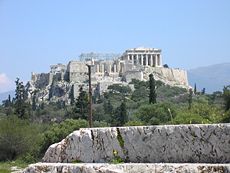
| |
| Type | Cultural |
| Criteria | i, ii, iii, iv, vi |
| Reference | 404 |
| Region** | Europe and North America |
| Inscription history | |
| Inscription | 1987 (11th Session) |
| * Name as inscribed on World Heritage List. ** Region as classified by UNESCO. | |
The Acropolis of Athens is the best known acropolis (high city, The "Sacred Rock") in the world. Although there are many other acropoleis in Greece, the significance of the Acropolis of Athens is such that it is commonly known as "The Acropolis" without qualification. The Acropolis is a flat-topped rock which rises 512 feet above sea level in the city of Athens. It was also known as Cecropia, after the legendary serpent-man, Kekrops or Cecrops, the first Athenian king.
The Acropolis of Athens was inhabited as far back as 3000 B.C.E., and by the year 1400 B.C.E. had become part of a powerful Mycenaean city. Legend recounts that in the year 510 B.C.E. an oracle from the priestess of Delphi decreed that the Acropolis should no longer be inhabited by man and should remain the province of the gods forever more.
Under the city-state ruler Pericles, a golden era in Athens began in the fifth century. The city was transformed into one of the most spectacular cities in the world. Taxes from all the other city states of Ancient Greece created a monumental home of the gods, including exquisite marble temples, which were embellished through rich paintings, precious jewels, huge statues, and elaborate friezes. The centerpiece was the magnificent Parthenon, the temple of the virgin Athena who, according to Greek legend, won the city in a contest against the god Poseidon, gave her name to Athens, and was subsequently revered by the people of ancient Greece.
The Acropolis was designated as a UNESCO World Heritage site in 1987, for its, "Illustrating the civilizations, myths, and religions that flourished in Greece over a period of more than 1,000 years, the Acropolis, the site of four of the greatest masterpieces of classical Greek art—the Parthenon, the Propylaea, the Erechtheum, and the Temple of Athena Nike—can be seen as symbolizing the idea of world heritage." In 2007, the Acropolis was formally proclaimed as the pre-eminent monument on the European Cultural Heritage list of monuments.
History
Early human occupation
While the earliest artifacts date to the Middle Neolithic era, there have been documented habitations in southern Greece from the Early Neolithic (sixth millennium B.C.E.). Once into the Bronze Age, there is little doubt that a Mycenaean megaron must have stood on top of the Acropolis, housing the local potentate and his household, guards, the local cult facilities, and a number of workshops and ordinary habitations. The compound was surrounded by a thick Cyclopean circuit wall, possibly between 14.8 feet thick and 19.7 feet in height, consisting of two parapets built with large stone blocks and cemented with an earth mortar called emplekton.
The wall follows typical Mycenaean convention in that its gate was arranged obliquely, with a parapet and tower overhanging the incomers' right-hand side, thus facilitating defense. There were two lesser approaches up the hill on its north side, consisting of steep, narrow flights of steps cut in the rock. Homer is assumed to refer to this fortification when he mentions the "strong-built House of Erechtheus" (Odyssey 7.81). It was during that time that an earthquake caused a fissure near the northeastern edge, one that ran all the way down to the marl layer and in which water collected. An elaborate set of stairs was built and the well was used as a protected source of drinking water during some portion of the Mycenaean period, as it was invaluable in times of siege.
The Dark Ages
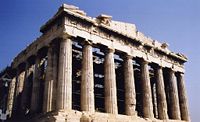
It seems that the Acropolis might have been spared the violent destruction of other Mycenaean palaces, as there are no signs of fire or other large-scale destruction in what few artifacts of that time survive. This agrees with the standard Athenian folklore that the area resisted the Dorians successfully. Not much is known as to the precise state of building on the rock leading up to the archaic era, except that the Acropolis was taken over by Kylon in the Kylonian revolt, and twice by Pisistratus: all attempts directed at seizing political power by coups d' etat. Nevertheless, it seems that a nine-gate wall, the Enneapylon, had been built around the biggest water spring, the "Clepsydra," at the northwestern foot. It was Pisistratus who initially established a precinct for Artemis on the site.
Archaic Acropolis
A sizable temple sacred to "Athena Polias" (Protectress of the City) was erected by mid-sixth century B.C.E. This Doric limestone building, from which many relics survive, is referred to as the "Bluebeard" temple, named after the pedimental three-bodied man-serpent sculpture, whose beards were painted dark blue. Whether this temple replaced an older one, or a mere sacred precinct or altar, is not known. In the late-sixth century B.C.E. yet another temple was built, usually referred to as the Archaios Naos (Old Temple). It is thought that the so-called Doerpfeld foundations might have belonged to this temple, which may have been sacred not to Polias but to Athena Parthenos (Virgin), at least for as long as the Polias "Bluebeard" temple stood. It is not known how long these temples coexisted.
To confuse matters, by the time the "Bluebeard" Temple had been dismantled, a newer and grander marble building, the "Older Parthenon," was started following the victory at Marathon in 490 B.C.E. To accommodate it, the south part of the summit was cleared of older remnants, made level by adding some 8,000 two-ton blocks of Piraeus limestone, a foundation 36 feet deep at some points, and the rest filled with earth kept in place by the retaining wall. The Mycenaean gate was demolished and replaced with the Old Propylon, a monumental colonnaded structure whose purpose was strictly ceremonial, rather than defensive.
The Older Parthenon was caught unfinished by the invading Persians in 480 B.C.E., and was razed to the ground burnt and looted, along with the Archaios Neos and practically everything else on the rock. Once the Persian Wars were over, the Athenians brought some order to the location, firstly by ceremonially burying objects of worship and art that were rendered unsuitable for further use. This "Persian debris" is the richest archaeological treasure excavated on the Acropolis, as its burial had protected it from further destruction through the ages.
The Periclean building program
Most of the major temples were rebuilt under the leadership of Pericles during the Golden Age of Athens (460–430 B.C.E.). Phidias, a great Athenian sculptor, and Ictinus and Callicrates, two famous architects, were responsible for the reconstruction. During the fifth century B.C.E., the Acropolis gained its final shape. After winning at Eurymedon in 468 B.C.E., Cimon and Themistocles ordered the reconstruction of southern and northern walls, and Pericles entrusted the building of the Parthenon to Ictinus and Phidias.
The Parthenon had eight fluted columns at either end and 17 on each side (these days often clad in scaffolding). The ceiling was painted blue and decorated with stars and a spectacular statue of the goddess, clad in a gold dress and bedecked with jewels, was erected on a pedestal in the inner sanctuary. The statue was lost after being taken to Constantinople in the year 426 C.E.
In 437 B.C.E., Mnesicles started building the Propylaea, monumental gates with columns of Penteli marble, partly built upon the old propylaea of Pisistratus. These colonnades were almost finished in the year 432 B.C.E. and had two wings, the northern one serving as picture gallery. At the same time, south of the propylaea, building of the small Ionic Temple of Athena Nike commenced. After an interruption caused by the Peloponnesian War, the temple was finished in the time of Nicias' peace, between 421 B.C.E. and 415 B.C.E.
During the same period the building of the Erechtheum, a combination of sacred precincts including the temples of Athena Polias, Poseidon, Erechtheus, Cecrops, Erse, Pandrosos, and Aglauros, with its so-called the Kore Porch (or Caryatids' balcony), was begun.
Between the temple of Athena Nike and the Parthenon there was the temenos of Artemis Brauronia or Brauroneion, the goddess represented as a bear and worshipped in the deme of Brauron. The archaic xoanon of the goddess and a statue made by Praxiteles in the fourth century B.C.E. were both in the sanctuary.
Behind the Propylaea, Phidias' gigantic bronze statue of Athena Promachos ("she who fights in the front line"), built between 450 B.C.E. and 448 B.C.E., dominated. The base was 4.9 feet high, while the total height of the statue was 29.5 feet. The goddess held a lance whose gilt tip could be seen as a reflection by crews on ships rounding Cape Sounion, and a giant shield on the left side, decorated by Mys with images of the fight between the Centaurs and the Lapiths. Other monuments that have left almost nothing visible to the present day are the Chalkotheke, the Pandroseion, Pandion's sanctuary, Athena's altar, Zeus Polieus's sanctuary and, from Roman times, the circular temple of Augustus and Rome.
Archaeological remains
The entrance to the Acropolis was a monumental gateway called the Propylaea. To the south of the entrance is the tiny Temple of Athena Nike. A bronze statue of Athena, sculpted by Phidias, originally stood at its center. At the center of the Acropolis is the Parthenon or Temple of Athena Parthenos (Athena the Virgin). East of the entrance and north of the Parthenon is the temple known as the Erechtheum. South of the platform that forms the top of the Acropolis there are the also the remains of an outdoor theatre called Theatre of Dionysus. Several hundred feet away, there is the, now partially reconstructed Theatre of Herodes Atticus.
Site plan
- Parthenon
- Old Temple of Athena
- Erechtheum
- Statue of Athena Promachos
- Propylaea
- Temple of Athena Nike
- Eleusinion
- Sanctuary of Artemis Brauronia or Brauroneion
- Chalkotheke
- Pandroseion
- Arrephorion
- Altar of Athena
- Sanctuary of Zeus Polieus
- Sanctuary of Pandion
- Odeon of Herodes Atticus
- Stoa of Eumenes
- Sanctuary of Asclepius or Asclepieion
- Theatre of Dionysus Eleuthereus
- Odeon of Pericles
- Temenos of Dionysus Eleuthereus
- Aglaureion
Cultural significance
Every four years the Athenians held a festival called the Panathenaea that rivaled the Olympic Games in popularity. During the festival, a procession moved through Athens up to the Acropolis and into the Parthenon (as depicted in the frieze on the inside of the Parthenon). There, a vast robe of woven wool (peplos) was ceremoniously placed on Phidias' massive ivory and gold statue of Athena.
ReferencesISBN links support NWE through referral fees
- Hurwit, Jeffrey M. The Athenian Acropolis: History, Mythology, and Archaeology from the Neolithic Era to the Present, Cambridge University Press, 2000. ISBN 978-0521428347
- Hurwit, Jeffrey M. The Acropolis in the Age of Pericles, Cambridge University Press, 2004. ISBN 978-0521527408
- Neils, Jenifer (Ed.) The Parthenon: From Antiquity to the Present, Cambridge University Press, 2005. ISBN 978-0521820936
- Rhodes, Robin Francis. Architectural Meaning of the Athenian Acropolis, Cambridge University Press, 1995. ISBN 978-0521469814
External links
- The Acropolis of Athens (Greek Government website)
- Reconstruction of the ancient Acropolis
- The Acropolis of Athens Interactive 360° panoramas of the Acropolis monuments in high resolution.
Credits
New World Encyclopedia writers and editors rewrote and completed the Wikipedia article in accordance with New World Encyclopedia standards. This article abides by terms of the Creative Commons CC-by-sa 3.0 License (CC-by-sa), which may be used and disseminated with proper attribution. Credit is due under the terms of this license that can reference both the New World Encyclopedia contributors and the selfless volunteer contributors of the Wikimedia Foundation. To cite this article click here for a list of acceptable citing formats.The history of earlier contributions by wikipedians is accessible to researchers here:
The history of this article since it was imported to New World Encyclopedia:
Note: Some restrictions may apply to use of individual images which are separately licensed.
